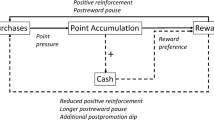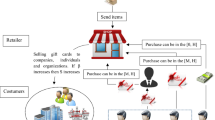Abstract
This study analytically examines online promotions with gift rewards based on data from a Chinese tea retailer, Huiliu. Gift rewards benefit Huiliu by improving promotional performance. However, they generate operational problems, especially by increasing the costs of holding gift inventory. To address Huiliu’s concerns about gift rewards, we first conduct an empirical study based on Huiliu’s promotional data to examine the effect of gift rewards on customer purchase behavior. The empirical result suggests that gift rewards induce more repeat customer purchases; however, they do not induce customers to spend more money. This empirical result reveals that the effect of gift rewards on customer purchase behavior leads to Huiliu’s intensifying gift inventory pressure. Based on this empirical finding, we develop a theoretical model that addresses gift inventory management. Because of the difficulty of precisely estimating the distributions of some key random variables (e.g., customer demands), we employ a robust approach to solve this model and provide near-optimal robust solutions. We finally present a case study to illustrate how to improve Huiliu’s gift allocation based on the robust inventory solutions. The numerical results show that the improved gift allocation significantly increases Huiliu’s profits (the average profit increment is 3.58%).
Similar content being viewed by others
Notes
For example, \( T = 7 \) if the promotion period is 1 week, and the time unit is 1 day.
The matching and reward policy in our model is consistent with the one used by the tea retailer in China.
References
Ben-Tal, A., & Nemirovski, A. (1998). Robust convex optimization. Mathematics of Operations Research,23(4), 769–805.
Berger, P. D., & Bechwati, N. N. (2001). The allocation of promotion budget to maximize customer equity. Omega,29(1), 49–61.
Bertsimas, D., & Sim, M. (2004). The price of robustness. Operations Research,52(1), 35–53.
Borle, S., Singh, S. S., & Jain, D. C. (2008). Customer lifetime value measurement. Management Science,54(1), 100–112.
Chan, T. Y., Wu, C., & Xie, Y. (2011). Measuring the lifetime value of customers acquired from Google search advertising. Marketing Science,30(5), 837–850.
Chun, H. H., & Hiang, Y. W. (2016). Free drink or free mug? Managing service experience with experiential vs. material complimentary gifts. Service Science,8(2), 184–202.
Delanote, S., Leus, R., & Nobibon, F. T. (2013). Optimization of the annual planning of targeted offers in direct marketing. Journal of the Operational Research Society,64(12), 1770–1779.
Dwyer, F. R. (1989). Customer lifetime valuation to support marketing decision making. Journal of Direct Marketing,3(4), 8–15.
Fader, P. S., Hardie, B. G. S., & Lee, K. L. (2005). RFM and CLV: Using iso-value curves for customer base analysis. Journal of Marketing Research,42(4), 415–430.
Gaeth, G. J., Levin, I. P., Chakraborty, G., & Levin, A. M. (1991). Consumer evaluation of multi-product bundles: An information integration analysis. Marketing Letters,2(1), 47–57.
Gallego, G., & Moon, I. (1993). The distribution free newsboy problem: Review and extensions. Journal of the Operational Research Society,44(8), 825–834.
Kopalle, P. K., Sun, Y., Neslin, S. A., Sun, B., & Swaminathan, V. (2012). The joint sales impact of frequency reward and customer tier components of loyalty programs. Marketing Science,31(2), 216–235.
Kumar, V., Venkatesan, R., Bohling, T., & Beckmann, D. (2008). Practice prize report—The power of CLV: Managing customer lifetime value at IBM. Marketing Science,27(4), 585–599.
Palmeira, M. M., & Srivastava, J. (2013). Free offer ≠ cheap product: A selective accessibility account on the valuation of free offers. Journal of Consumer Research,40(4), 644–656.
Rust, R. T., & Chung, T. S. (2006). Marketing models of service and relationships. Marketing Science,25(6), 560–580.
Venkatesan, R., & Kumar, V. (2004). A customer lifetime value framework for customer selection and resource allocation strategy. Journal of Marketing,68(4), 106–125.
Yue, J., Chen, B., & Wang, M. C. (2006). Expected value of distribution information for the newsvendor problem. Operations Research,54(6), 1128–1136.
Acknowledgements
The authors would like to thank the two referees and Associate Editor for their careful review of the paper and helpful comments and thank Huiliu for providing the data used in this study. This work is supported by National Natural Science Foundation of China (Nos. 71801207, 71520107002, 71771201), and the China Postdoctoral science foundation (No. 2017M612100).
Author information
Authors and Affiliations
Corresponding author
Additional information
Publisher's Note
Springer Nature remains neutral with regard to jurisdictional claims in published maps and institutional affiliations.
Rights and permissions
About this article
Cite this article
Yu, H., Shi, Y., Yu, Y. et al. Business analytics: online promotion with gift rewards. Ann Oper Res 291, 1061–1076 (2020). https://doi.org/10.1007/s10479-019-03193-3
Published:
Issue Date:
DOI: https://doi.org/10.1007/s10479-019-03193-3




